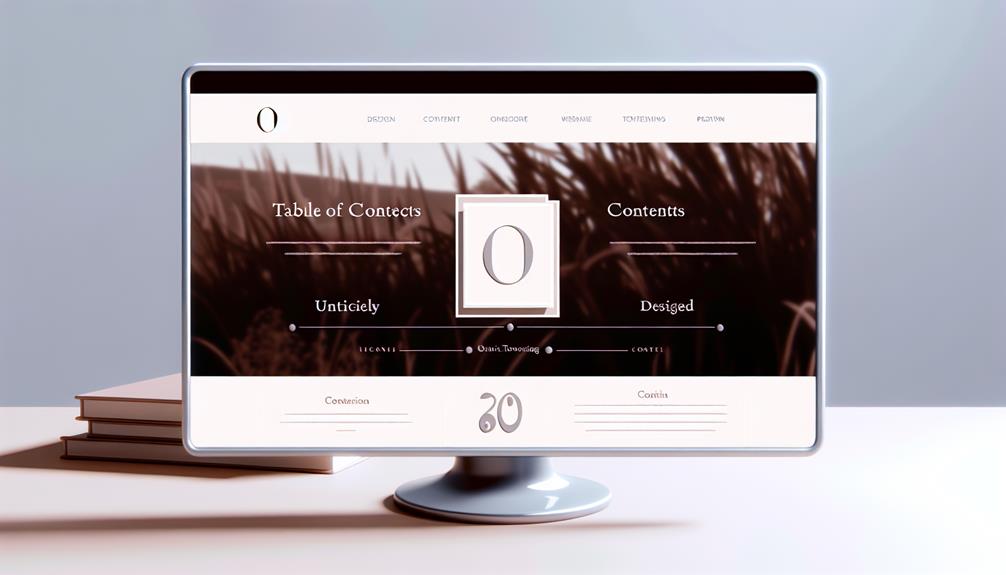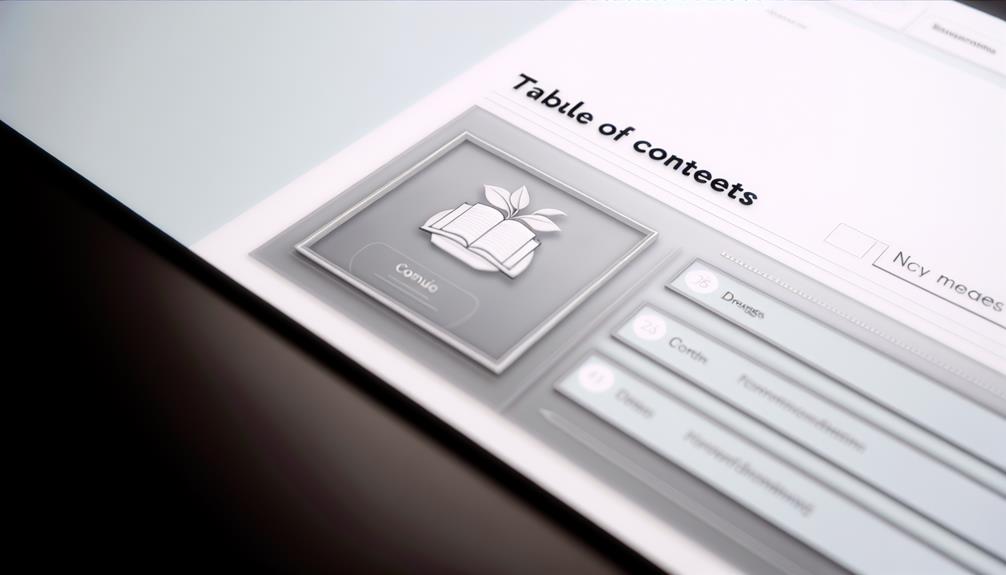Adding a Table of Contents (ToC) icon greatly improves website navigation by offering users a straightforward path to specific content sections. This enhances the overall user experience, reducing frustration and the likelihood of high bounce rates. A well-placed ToC fosters accessibility, encouraging engagement across diverse user demographics. Utilizing clear and contrasting designs for the icon guarantees visibility, while responsive layouts maintain functionality across devices. By strategically implementing this feature, websites can cultivate a more inviting atmosphere that encourages exploration. Discovering further insights on optimizing ToC icons can elevate your navigation strategies even more.
Key Takeaways
- A Table of Contents (ToC) icon enhances user navigation by providing quick access to specific sections of content.
- Position the ToC icon prominently, ideally in the top left corner, for maximum visibility and accessibility.
- Use a minimalist design with contrasting colors to ensure the ToC icon is easily identifiable and aligns with the website's theme.
- Incorporate interactive feedback, such as hover effects, to encourage users to engage with the ToC icon.
- Regularly collect user feedback to refine the ToC design and improve overall navigation experience.
Importance of User Navigation

Understanding the importance of user navigation is essential for creating an effective digital experience. User navigation serves as the backbone of any website, guiding visitors through its content and ensuring they find what they seek with ease. Additionally, implementing user-friendly navigation can greatly enhance engagement for various demographics, as seen in recommended exercise levels for different age groups and fitness levels finding the right exercise. By implementing thoughtful navigation strategies, designers can shape user behavior and enhance engagement, fostering a sense of belonging among users.
Effective navigation not only streamlines the user journey but also greatly impacts how visitors perceive the website's reliability and professionalism. When users encounter intuitive paths and clear labels, they are more likely to explore further and return in the future. Conversely, poor navigation can frustrate users, leading to increased bounce rates and diminished trust.
To cultivate a welcoming digital environment, it's imperative to prioritize user-friendly navigation. This involves understanding the target audience's needs and preferences, which can be identified through user behavior analysis. By leveraging insights from this data, web developers can create navigation systems that resonate with users, inviting them to engage more deeply with the content. Ultimately, a well-structured navigation framework not only enhances the user experience but also strengthens the overall connection between the website and its audience.
Benefits of a Table of Contents
A well-structured Table of Contents greatly enhances the user experience by allowing readers to navigate content effortlessly. This is particularly important when discussing complex topics, as it allows users to quickly find relevant sections and information, such as strengthening intimacy for a healthier relationship. Additionally, it can improve SEO performance by providing search engines with a clear outline of the page structure. Ultimately, quick access to specific sections elevates the overall effectiveness of the content, making it more user-friendly and engaging.
Enhanced User Experience
Implementing a Table of Contents (ToC) greatly enhances user experience by providing readers with a clear roadmap to navigate through content. This intuitive design not only facilitates content organization but also fosters a sense of belonging among users by making information more accessible. By structuring content with a visual hierarchy, readers can quickly identify and jump to sections of interest, markedly improving engagement metrics.
Moreover, user feedback consistently highlights the importance of easy navigation in enhancing overall satisfaction. A well-implemented ToC incorporates interactive elements that encourage users to explore content dynamically, creating a more immersive experience. This is particularly essential in today's digital landscape, where mobile responsiveness is paramount; a responsive ToC guarantees that users on all devices can navigate seamlessly.
Adhering to accessibility standards is another critical aspect of a ToC, as it guarantees that all users, including those with disabilities, can navigate content effectively. By prioritizing these elements, website owners can create a user-friendly environment that not only retains visitors but also encourages them to return, fostering a loyal and engaged community.
Improved SEO Performance
Integrating a Table of Contents (ToC) not only enhances user experience but also greatly contributes to improved SEO performance. A well-structured ToC assists in defining content structure, which is essential for effective SEO strategies. By clearly outlining the main topics and subtopics, it aids search engines in understanding the hierarchy and relevance of your content, ultimately enhancing keyword optimization.
Moreover, a ToC can improve meta descriptions by providing concise summaries of each section, making it easier for users to grasp your content's value. This clarity aligns with user intent, encouraging higher engagement and reducing bounce rates—key on-page factors that search engines prioritize.
Additionally, a ToC can positively influence backlink quality; when users find your content easily navigable, they are more likely to share it, thereby increasing organic traffic. As mobile responsiveness becomes increasingly important, a ToC guarantees that users on all devices can access your content seamlessly, contributing to improved page speed and overall site performance.
Incorporating a Table of Contents is not just a functional enhancement; it's a strategic move that can notably bolster your website's SEO performance.
Quick Content Access
One of the primary advantages of incorporating a Table of Contents (ToC) is its ability to provide quick content access for users. In an era where attention spans are short, a well-organized ToC can greatly enhance user experience by helping visitors find relevant information effortlessly. This strategic tool not only streamlines navigation but also fosters a sense of belonging within your audience, as they can easily locate the content they seek.
Here are four benefits of integrating a Table of Contents into your website:
- Enhanced User Experience: Users can navigate directly to their desired sections, leading to increased satisfaction.
- Content Organization: A clear ToC allows for logical content flow, making it easier for users to understand the structure of your material.
- Reduced Frustration: Quick access to information minimizes the time spent searching, helping to retain user interest.
- Increased Engagement: When users can find what they need quickly, they are more likely to explore other sections of your site.
Enhancing User Experience

Enhancing user experience is fundamental for creating intuitive and engaging digital environments. By prioritizing user feedback during the design testing phases, websites can align more closely with user preferences and behaviors. Understanding navigation patterns is essential in crafting a seamless journey through content. When a Table of Contents icon is implemented effectively, it not only improves content structure but also enhances visual hierarchy, guiding users through their experience. Additionally, incorporating gentle exercises for safe detox and wellness can be beneficial for users seeking health-related content, as they encourage a holistic approach to wellbeing gentle movement benefits.
Moreover, adherence to accessibility standards guarantees that all users, regardless of ability, can navigate the site with ease. Incorporating mobile optimization is imperative, as more users access content via mobile devices. This approach requires thoughtful interaction design that adjusts to various screen sizes while maintaining functionality.
Encouraging Deeper Engagement
User engagement is markedly influenced by the design elements that facilitate interaction and understanding. For instance, creating interactive features similar to those in successful games like Farm Merge Valley can greatly boost user involvement. To cultivate a sense of belonging and encourage deeper engagement, implementing strategic engagement strategies is essential. By incorporating interactive features that resonate with users, you can greatly enhance their experience. Here are four effective methods to achieve this:
- Content Variety: Offer diverse formats such as videos, infographics, and articles to cater to different preferences, thereby improving attention retention.
- User Feedback: Regularly solicit and analyze user feedback to refine your navigation patterns and address user concerns, fostering a sense of community.
- Content Segmentation: Organize content into clearly defined sections, leveraging visual hierarchy to guide users seamlessly through their journey, enhancing user flow.
- Engagement Metrics: Track engagement metrics to identify trends and adjust strategies accordingly, ensuring that your website continues to meet users' evolving needs.
Improving Content Accessibility

Improving Content Accessibility
Accessibility is a significant aspect of content creation, impacting how effectively information can be shared and understood by a diverse audience. By prioritizing accessibility standards, we can enhance content structure and guarantee that all users, regardless of their abilities, can navigate and engage with our websites seamlessly. This is similar to how the addictive nature of clicker games draws players in and keeps them engaged through structured, clear progression.
Implementing user-centric design principles is essential in creating navigation aids that cater to various needs. A well-designed visual hierarchy not only guides users through content but also greatly improves content discoverability. This is particularly important for those using assistive technologies, as clear headings and organized layouts facilitate easier comprehension and interaction with the material.
Moreover, responsive design plays a key role in enhancing mobile accessibility. As an increasing number of users access content via mobile devices, guaranteeing that navigation remains intuitive and effective across different screen sizes is imperative. By fostering an inclusive environment, we encourage a sense of belonging and community among our audience.
Ultimately, improving content accessibility is not just a regulatory obligation; it is an important strategy that enriches the user experience and elevates the overall impact of our content.
Designing an Effective TOC Icon
Creating a visually appealing and functional Table of Contents (TOC) icon is essential for guiding users through digital content efficiently. A well-designed TOC icon not only enhances icon aesthetics but also greatly improves icon usability. To achieve this, consider the following elements:
- Simplicity: Opt for a minimalist design that conveys the purpose of the icon at a glance, ensuring it is easily recognizable.
- Color Contrast: Use colors that stand out against the background, making the icon prominent without being overwhelming. This helps users locate the icon quickly.
- Consistent Style: Align the TOC icon's design with the overall website theme. Consistency fosters a sense of belonging and encourages users to engage with the content.
- Interactive Feedback: Incorporate visual cues, such as hover effects, to signal interactivity. This enhances usability, inviting users to click and explore further.
Placement and Visibility Tips

Effective design elements alone are not sufficient if the Table of Contents (TOC) icon lacks proper placement and visibility. To guarantee that your audience can easily locate the TOC, consider strategically positioning the icon within the webpage layout. The top left corner is often ideal, as it is one of the first areas users tend to scan. Additionally, placing the icon in proximity to the main content enhances its accessibility, inviting users to engage with it.
Visibility strategies are equally important. Utilize contrasting colors and clear typography for the icon, guaranteeing that it stands out against the background. Consistent use of size and style across your website can also reinforce its importance. Remember, an animated hover effect can draw attention while maintaining professionalism.
Furthermore, consider responsive design principles; guarantee the TOC icon remains prominent on both desktop and mobile devices. By thoughtfully addressing icon placement and implementing effective visibility strategies, you create a seamless navigation experience that fosters a sense of belonging for your audience, allowing them to navigate your content with ease and confidence.
Tools for Creating a TOC
A well-crafted Table of Contents (TOC) serves as a roadmap for users traversing complex documents or web pages, making the choice of tools for its creation crucial. Selecting the right TOC creation tools can enhance usability and engagement for your audience. Here are four key options to take into account:
- TOC Design Software: Look for software that offers intuitive interfaces, allowing for easy layout and aesthetics. This can greatly improve the visual appeal of your TOC.
- TOC Automation Features: Opt for tools that automate the TOC generation process, guaranteeing that updates to the document are seamlessly reflected. This saves time and reduces errors.
- TOC Customization Options: Choose tools that allow for personalization, from font styles to colors and indentation. Tailoring the TOC to your brand enhances user connection.
- TOC Integration Methods: Confirm that the chosen tool easily integrates with your existing content management system, facilitating a smooth user experience.
Incorporate TOC usability testing into your development process to verify that users find your TOC intuitive and helpful. Utilizing these tools effectively can transform navigation, fostering a sense of belonging among users.
Best Practices for Implementation

When implementing a Table of Contents icon, careful consideration of icon design is vital to guarantee it is both visually appealing and functional. Additionally, strategic placement and visibility are essential for facilitating easy access, enhancing the overall user experience. Focusing on these aspects will help create an intuitive navigation tool that benefits all users.
Icon Design Considerations
Designing an effective icon for a table of contents requires careful attention to several key considerations that can enhance both functionality and user experience. An icon serves as a visual guide, and its design can notably influence how users interact with your website.
- Icon Aesthetics: Aim for a design that balances creativity and clarity, guaranteeing the icon aligns with your overall website theme.
- Color Psychology: Utilize colors that evoke the desired emotions and actions. For example, calming blues can encourage exploration, while vibrant reds can signal urgency.
- User Familiarity: Design the icon with recognizable symbols to foster instant recognition, enhancing user confidence in maneuvering your site.
- Accessibility Considerations: Confirm the icon is easily distinguishable for all users, including those with visual impairments. High contrast and alternative text can aid this.
Placement and Visibility
Strategically positioning the table of contents icon is essential for maximizing its visibility and effectiveness. To enhance icon positioning, consider placing it prominently at the top of the page or in the navigation menu. This allows users to easily locate it without excessive scrolling or searching. A consistent location across multiple pages fosters familiarity, encouraging users to engage with the content.
Visibility strategies should also include contrasting colors and clear design to guarantee the icon stands out against the background. Using intuitive symbols, such as a list or bulleted icon, can further attract attention and convey functionality. Additionally, consider implementing hover effects or animations that draw the eye to the icon, making it more noticeable.
Incorporating responsive design principles guarantees that the icon remains accessible on various devices, accommodating a diverse audience. By prioritizing placement and visibility, website owners can create an inviting navigation experience, fostering a sense of belonging among users. Ultimately, thoughtful icon positioning and visibility strategies contribute to a more organized and user-friendly website, enhancing overall satisfaction and engagement.
User Experience Focus
A well-executed user experience is essential for guaranteeing that the table of contents icon effectively serves its purpose. To enhance user satisfaction and engagement, focus on the following best practices for implementation:
- Clear Icon Design: Guarantee that the table of contents icon is easily recognizable. Use familiar symbols that align with standard user interfaces, like a book or list, to promote instant understanding.
- Strategic Placement: Position the icon where users naturally expect it, such as at the top or in a fixed sidebar. This enhances its visibility and facilitates seamless navigation.
- Visual Hierarchy: Utilize size, color, and spacing to create a clear visual hierarchy. The icon should stand out without overwhelming other elements, guiding users effortlessly through the content.
- Responsive Design: Guarantee the icon is accessible on all devices. A responsive design adjusts the icon's size and placement, maintaining usability across various screen resolutions.
Frequently Asked Questions
Can a TOC Icon Affect Website Loading Speed?
The placement of a Table of Contents (TOC) icon can influence website loading speed, albeit marginally. While the icon itself typically requires minimal resources, its implementation must be strategic to enhance the overall user experience. A well-placed TOC icon can streamline navigation, reducing the time users spend searching for information. However, excessive reliance on complex scripts or large graphics for the icon may inadvertently slow down loading times, detracting from the intended benefits.
Are There Specific Icons Recommended for a TOC?
When considering TOC icon styles, it is essential to align with contemporary TOC design trends to enhance usability and aesthetic appeal. Popular choices include minimalist icons, which foster a clean look, and directional arrows that intuitively guide users. Additionally, incorporating universally recognized symbols, such as lists or bookmarks, can further establish familiarity. By thoughtfully selecting a TOC icon, websites can create a cohesive experience, fostering a sense of belonging and engagement among their audience.
How Do I Track TOC Usage Analytics?
To effectively track Table of Contents (TOC) usage analytics, focus on key TOC engagement metrics such as click-through rates, time spent interacting with sections, and exit rates. Employ user behavior analysis tools, like Google Analytics, to gather insights on how users navigate through your content. This data not only highlights the effectiveness of your TOC but also fosters a deeper understanding of user preferences, ultimately enhancing the overall website experience for your audience.
Will a TOC Icon Help With SEO Rankings?
Incorporating a Table of Contents (TOC) icon can indeed provide SEO benefits by enhancing user experience. A well-structured TOC allows users to navigate content efficiently, reducing bounce rates and increasing engagement. These factors are essential for search engine algorithms, which prioritize user satisfaction. As a result, a TOC not only aids in content accessibility but may also indirectly improve your SEO rankings, fostering a sense of belonging among users seeking streamlined information.
Can I Customize the TOC Icon for Branding?
Yes, you can customize the Table of Contents (TOC) icon to reflect your brand identity. Implementing a custom icon design enhances branding consistency across your website, reinforcing your brand's visual identity. By aligning the TOC icon with your overall aesthetics, you create a cohesive user experience that resonates with your audience. This thoughtful customization not only elevates your site's appeal but also fosters a sense of belonging among users who connect with your brand.
